
Dynamics 365 Human resources merged into Dynamics 365 for Finance and Operations
Microsoft recently announced the merge of Dynamics 365 Human resources into Dynamics 365 for Finance and Operations cross-app capabilities!
This is great news as organisations will not have to worry about integration between D365 Human Resources and D365 Finance and Operations anymore while getting all the functionality present in D365 Human Resources. However, several elements should be considered when thinking about the transition.
Journey of Dynamics 365 Human Resources so far
Originally, Human Resources was a module within Dynamics 365 for Finance and Operations. In July 2017, most of the existing functionality was used to create a standalone application which has been subsequently enhanced as can be seen below.
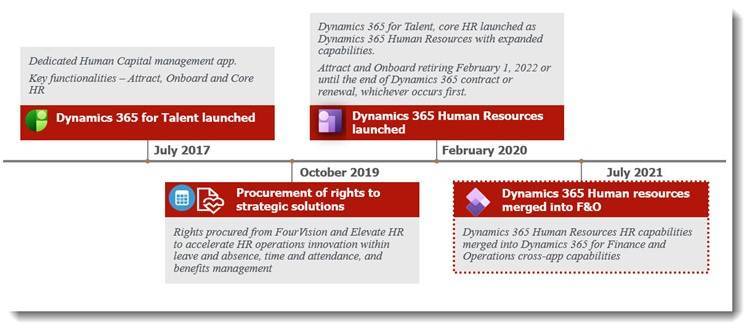
What is Dynamics 365 Human Resources?
Dynamics 365 Human Resources is a SaaS (Software as a Service) product that allows customers to manage human resources in a rich, browser-based user experience with workspaces tailored to specific roles.
It helps customers achieve a transformed employee experience, optimised HR programs, increased organisational agility, workforce insights discovery with out-of-the-box capabilities and custom integrations. The solution is seamlessly integrated with Dataverse (formerly called Common Data Service) providing powerful integration and extension capabilities with Power Platform.
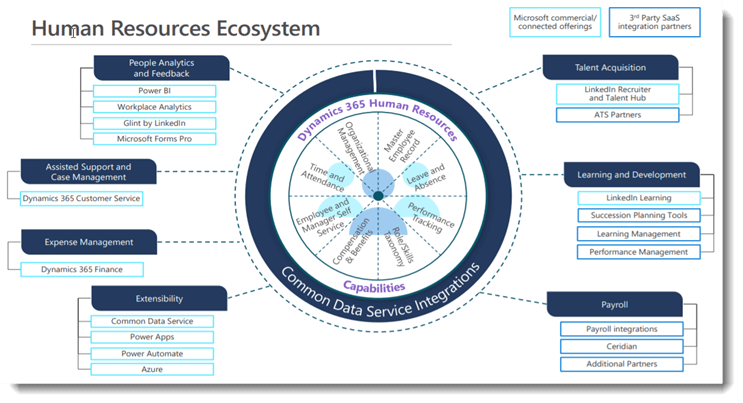 Microsoft Dynamics 365 Human Resources Ecosystem, with Microsoft offerings and 3rd Party SaaS integration partners
Microsoft Dynamics 365 Human Resources Ecosystem, with Microsoft offerings and 3rd Party SaaS integration partners
What is Dynamics 365 for Finance and Operations?
Dynamics 365 is a set of intelligent business applications that work together seamlessly and span across Marketing, Services, Sales, Operations, Finance, Commerce and Human Resources.
It combines CRM and Enterprise Resource Planning (ERP) capabilities by bringing them together in a powerful set of applications and moving them to the cloud.
It also connects with Power Platform and Microsoft Dataverse for insights, innovation, and connectivity between your data and your business processes.
Dynamics 365 for Finance and Operations is a collection of primarily four transactional applications derived from ERP, that help organisations automate processes and increase efficiency.
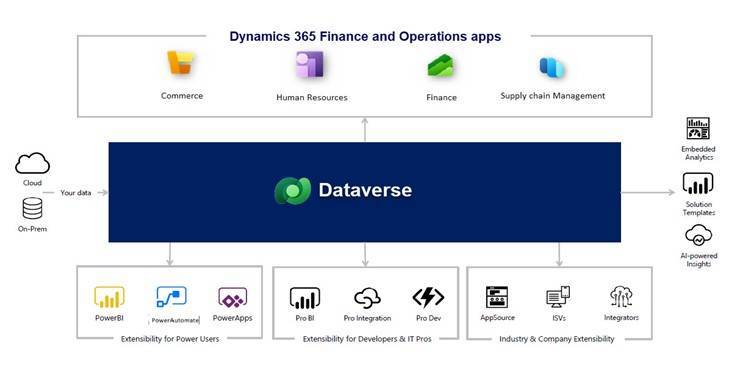
With this recent announcement, the HR capabilities of Dynamics 365 Human Resources will merge into the Finance and Operations infrastructure.
How does this impact new or existing D365 customers?
- New customers
- Going forwards, the steer is to implement the HR module within Dynamics 365 for Finance and Operations as opposed to the standalone Dynamics 365 Human Resources app.
- Existing customers fall under the following categories:
- Dynamics 365 Human Resources already implemented, but not using Finance and Operations.
- Microsoft are proposing that these customers will be moved from Dynamics 365 Human Resources to the Human Resources module within FinOps.
- When a customer has both Dynamics 365 Human Resources and FinOps
- The customer will still be moved from Dynamics 365 Human Resources to the Human Resources module in FinOps. However, several areas overlap in both HR and FinOps and will need to be aligned before the solution is unified within the FinOps infrastructure. These are known as cross-app capabilities which need to be considered when thinking about the transition from D365 Human Resources to D365 FinOps to make sure they are aligned.
- Dynamics 365 Human Resources already implemented, but not using Finance and Operations.
What are Dynamics 365 Finance and Operations cross-app capabilities?
Finance and Operations cross-app capabilities apply to all Finance and Operations apps like Dynamics 365 Finance, Dynamics 365 Supply Chain Management, Dynamics 365 Human Resources and Dynamics 365 Commerce.
In an overarching Dynamics 365 implementation, cross-app capability needs to be aligned to make sure all the solutions in Dynamics 365 work correctly and smoothly. For example, HR data mastered in Dynamics 365 Human resources, and used in FinOps for expenses, resourcing etc.
If they are not aligned, consideration must be given to ensure the cross-app capabilities are aligned to avoid any complications.
Let us discuss the highlighted Application Foundation cross-app capabilities required to configure the system to work smoothly and effectively for an organisation and business.
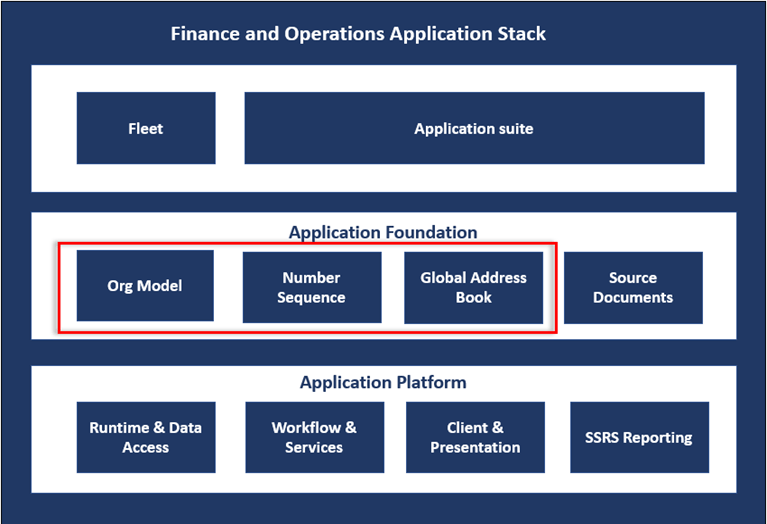 Dynamics 365 Finance and Operations Application Stack
Dynamics 365 Finance and Operations Application Stack
Global address book
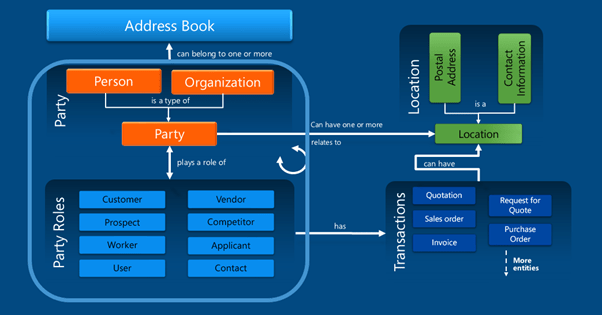
The global address book (GAB) is a centralised repository for master data that must be stored for all internal and external persons and organisations that the company interacts with. When an address changes, the update only needs to be made in one place. All the other associated records are updated automatically. For example, a party of type person can play a ‘Worker’ role and can also be a ‘Vendor’ for expense payments processing.
The data that is associated with party records includes the party’s name, address, and contact information. Other details vary, depending on whether the party is a person or an organisation.
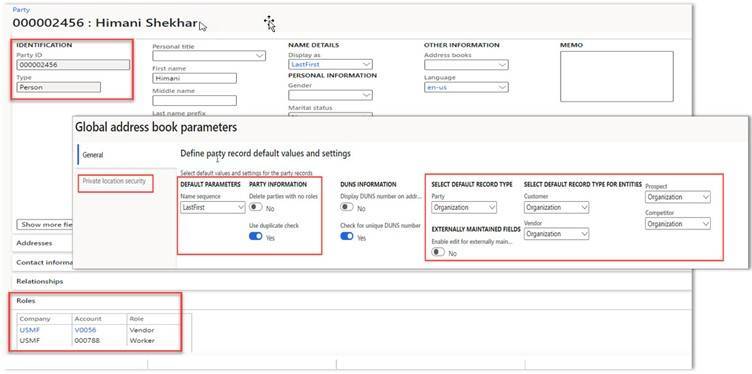
Organisation model and architecture
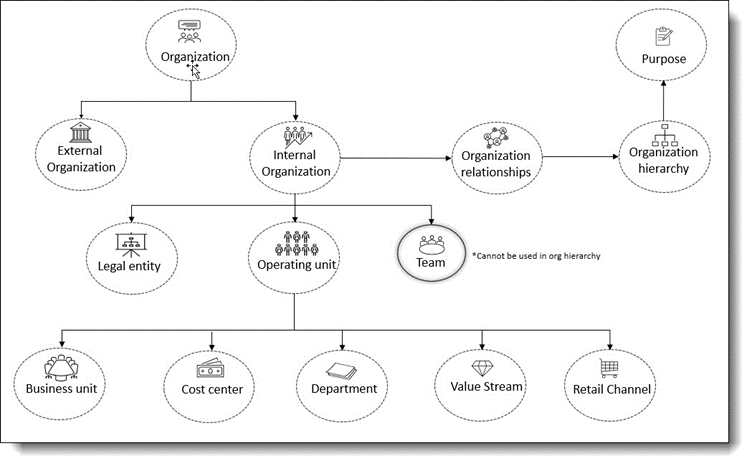
What is an organisation?
An organisation is a collection of people involved to pursue defined objectives. In Dynamics 365 for Finance and Operations, organisations can be broadly classified as Internal or External.
Examples of external organisations can be, for example, customer or vendor organisations and internal organisations can be broadly classified as Legal entities, Operating units, or Teams.
Internal Organisations
Legal Entities
At least one legal entity is required for the first phase of implementation, but what is a legal entity?
A legal entity is an organisation that is registered or is a legislated legal structure, can enter legal contracts and is required to prepare financial statements for reporting.
Every legal entity is associated with a company (via Company ID or DataAreaId in data models). Companies are used as data security boundaries.
The primary address of a legal entity controls the country and region-specific features. This Country/Region-specific feature was introduced in Dynamics AX 2012, one of the previous versions of Dynamics 365 for Finance and Operations.
Operating units
An operating unit is not required to be a legally defined organisation. They control economic resources and operational processes in the business. Types of operating units – Business units, Cost centre, Department, Value stream and Retail Channel.
Team
A team is an internal organisation where team members share a common objective or responsibility. Examples of a team, group of employees responsible for Mental Health of workers or a Sales team.
Organisation hierarchy
Organisational hierarchies represent the relationships between the organisations that make up a business. It represents the structure of the business. Hierarchies can address both organisational and statutory reporting needs.
For example, a hierarchy can comprise legal entities for legal and statutory reporting. For internal control, to report on financial information that is not legally required we can set up a hierarchy based on operating units.
Each hierarchy is assigned a purpose. Examples of Organisation hierarchy purpose include Procurement internal control, Organisation chart, Security etc. If multiple hierarchies have the same purpose, then a user can select a default hierarchy on the Organisation hierarchy purpose.
In the below screenshot, for Organisation chart purposes the default hierarchy is Home – Business unit.
The default hierarchy assigned to this purpose will be used as the Department hierarchy in Human Resource module.
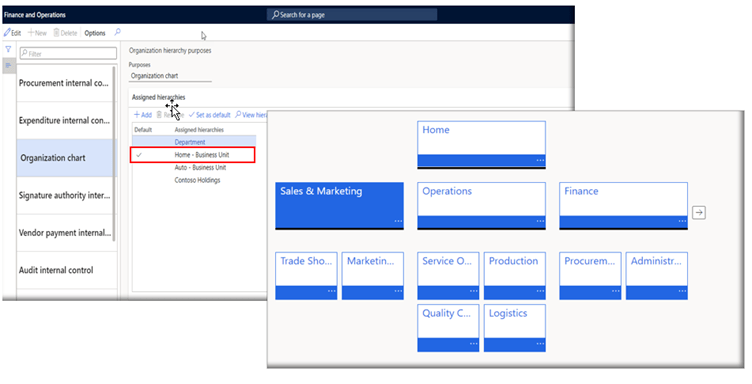
Note – All organisations in a hierarchy can share parameters, policies, and transactions. Any child organisation can inherit and override the parameters of its parent. Shared master data, such as products and address books, applies to the whole organisation and cannot be overridden for individual organisations.
Financial dimensions
Financial dimensions are data classifiers that are used for financial reporting. Concerning Human Resources, financial dimensions can be linked to Positions and Worker employment records. Financial dimensions identify information such as the business unit, cost centre and department.
There are two types of financial dimensions: custom dimensions and entity-backed dimensions.
Custom dimensions – These are user-defined financial dimensions shared across legal entities. Their values are entered and maintained by users.
Entity-backed dimensions – These are based on the selection of a system-defined entity, for example, Position or Worker. The financial dimension values are then created from the selected entity.
Number Sequences
Number sequences are used to generate readable, unique identifiers for master data records and transaction records that require identifiers.
A master data record or transaction record that requires an identifier is referred to as a reference. Before creating new records for a reference, a number sequence must be set up and should be associated with the reference.
When setting up a number sequence, the scope must be defined. The scope is used to define which organisation uses the number sequence. The scope can be Shared, Company, Legal entity, or Operating unit. Legal entity and Company scopes can be combined with a Fiscal calendar period to create even more specific number sequences.
In addition to segments that correspond to a particular scope, number sequence formats can contain Constant and Alphanumeric segments. A Constant segment contains a set of letters, numbers, or symbols that does not change.
An Alphanumeric segment contains letters or numbers that increment every time a number is used.
A number sign (#) is used to represent incrementing numbers and an ampersand (&) to represent incrementing letters. For example, the format #####_2017 creates the sequence 00001_2017, 00002_2017, and so on.
Other areas impacted by the merge.
In addition to the core application stack, there are few other key areas worth mentioning such as Personalisation’s, Saved Views, Integrations and Extensibility which can impact Dynamics 365 Human Resources existing customers.
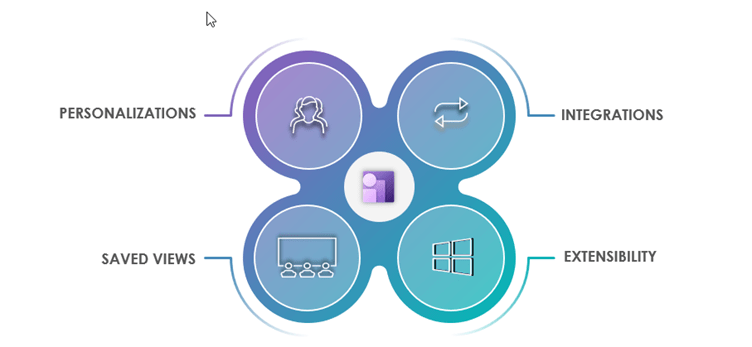
What is Personalisation?
In Dynamics 365 for Finance and operations, the word personalisation is used to indicate non-code changes to the system, especially in the user interface.
There are several ways to personalise the app as outlined below:
- System-wide options – These are available to all users and can be modified on a setup page, for example, time zone and colour theme.
- Restricted personalisation access – At this access level, any user actions associated with a page are automatically saved and restored on the next visit to the page. For example, expanded or collapsed Fast Tabs.
- Full personalisation access and Share personalisation – At this access level, users have access to all personalisation capabilities within the app including personalisation of toolbars and the exporting and sharing of page personalisation with other users.
- Administration of personalisation – At this level, privileged users can access the Personalisation administration page to manage all personalisation at an organisational level.
What are Saved Views?
By using the Saved views functionality, users can save multiple named sets of optimised personalisation per page. Users can quickly switch between the views as needed. The views can also include user-added filters or sorts, to quickly return tailored datasets.
Views can be published to users in specific security roles and specific legal entities. Administrators can import and export views in bulk.
Unlike traditional personalisation, views are not automatically saved when a user performs personalisation or filters a list. Explicit saves are required to give users the flexibility to create a view before or after the changes that are associated with that view have been made.
Integrations – Human Resources data integration with other applications
The realignment of Dynamics 365 Human Resources within Dynamics 365 FinOps brings together a variety of data integration technologies available for use with Human Resource data.
- Dataverse tables – Dataverse tables provide a secure option for organisations using cloud-based storage for their data. Dataverse allows data to be integrated from multiple sources into a single store, which can then be used in Power Apps, Power Automate, Power BI and Power Virtual Agents, along with data that is already available from the Dynamics 365 applications.
- DMF/DIXF entities – Data Management Framework (DMF). DMF is also known as the Data Import Export Framework (DIXF). FinOps provides a set of data entities that customers can use for importing and exporting Human Resources data. While Dataverse tables are one option, DMF entities are still useful in some circumstances, such as:
- Dataverse tables are not yet available.
- The integration requires high-performance bulk data import/export capabilities.
DMF entities currently provide the most complete data coverage for Human Resources data. It is not appropriate for real-time integrations.
- DMF Package REST API – The DMF provides a REST API for manipulating data packages. This API can be used to programmatically interact with the DMF for import, export of data packages or checking the status of import/export operations.
- BYOD – DMF additionally provides a powerful feature (known as Bring Your Own Database or BYOD) that allows Human Resources to export data to customer’s own Microsoft Azure SQL database. It is mainly a read-only solution. It is appropriate for reporting solutions and data integrations.
- OData-enabled entities – Most DMF entities are also enabled for access through the Human Resources data service (OData). OData currently has more complete entity coverage for the Human Resources data than Dataverse.
- Excel Add-in – The Excel Add-in makes use of OData-enabled entities beneath the surface. It provides a convenient way for an end-user to retrieve and modify Human Resources data through the familiar Excel UI.
- Data Integrator – Administrators can use the Data Integrator service to integrate data to and from Dataverse.
- Power Query – Data Integrator supports Power Query through its Advanced Query feature. Power Query provides powerful, flexible data filtering and transformation, including the rich M formula language.
Extensibility – How to previously extend Dynamics 365 Human Resources
Currently, Dynamics 365 Human resources (the SaaS solution) can only be extended with Power Platform via Microsoft Dataverse, for example, by embedding a Canvas app (which works with data stored in Dataverse) into D365 HR.
Benefits of the functional merge
- Greatly improved extensibility – Dynamics 365 Finance and Operations apps such as Finance, Supply Chain and Commerce can be extensively customised by partners, value-added resellers (VARs), and even some customers. With this merge, in addition to Power Platform extensibility, we get a significant improvement – FinOps customisation!
- Market clarity – Elimination of multiple sets of HR Capabilities within Dynamics 365.
- Consistency – This will bring consistency between HR and other FinOps apps in terms of Application Lifecycle Management, Geo availability, Fast track etc.
To learn more regarding Dynamics 365 Human resources, explore the blogs by our experts.
